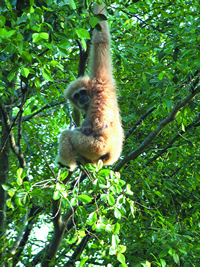The duet of the agile gibbon is thought to inform others of the territorial demarcation and deepen ties between mates. These creatures are now classified in about 10 species, and the duets are species specific. The Hoolock gibbon has an ancient lineage, and the males and females sing the same song together from beginning to end with the same vocalization. The agile gibbon, which developed later, divides the song into parts, however, with males and females singing their own repertory separately. Further, Kloss’s gibbon will sing its own part from memory even if it does not have a partner. It can apparently sing solo when it wants to sing.
If this solo is sung in response to the surrounding environment, we may consider that this does not differ greatly from the vocabulary we use every day. It is thought to be an activity just before the birth of language, and is remarkably similar to the way babies learn words: by extracting the vocabulary they like and saying the words. The song of the hylobatidae provides us a glimpse of human communication in prehistoric times. |

